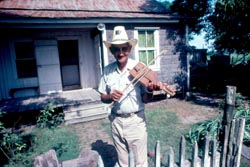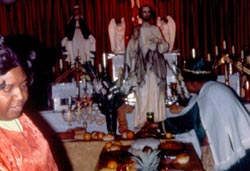The Creole State: An Introduction to Louisiana Traditional Culture
By Nicholas R. Spitzer
Louisiana is a state steeped in a variety of traditions, but is also pulled toward the cultural economic mainstream. Louisiana people are increasingly aware of the complex mixture of tradition and change found in a state that is part Sunbelt-suburban just as surely as it is still part pioneer, frontier, plantation, farmstead, fisherman's camp, and New Orleans neighborhood.
Predominately Catholic French southern Louisiana has been described as "South of the South" due to the Mediterranean-African roots and plantation past of the region, that make it and New Orleans more akin to societies in the Spanish and French West Indies than the American South. The rural part of South Louisiana is dominated by the Acadians, or Cajuns, who came from what is now Nova Scotia as petit habitants in the late eighteenth century. However, over time the Cajuns have absorbed and been affected by a wide array of cultures in the area: Spanish, German, Italian, Anglo, Native American, and Slavonian.
The distinctive foodways (gumbo, jambalaya, crawfish etouffee), music (Cajun music and zydeco), material culture (Creole cottages, shotgun houses, pirogues and bateaux), ritual/festive practices (folk Catholicism, home altars, traiteurs, Mardi Gras), and languages (Cajun and Creole French, Spanish, Dalmatian, and Indian languages), reflect a diversity of cultures unified in one region.
Some groups retain greater degrees of independence from Cajun culture. For example, Spanish-speaking Isleños of St. Bernard Parish are descended from Canary Islanders who arrived at the same time as the Acadians. Contemporary Isleños pride themselves as great duck hunters, fishermen, and trappers. Some still cook caldo and sing complex story songs called dècimas about the exploits of a cruel knight of the Middle Ages as well as a lazy fisherman in Delacroix today.
Indians, who inhabited the area before all others, have contributed to boat styles, folk medicine and other environmental use techniques. The Houma tribe conserves 19th century French folk culture. However, the Coushatta and Chitimacha have maintained greater separation from Cajun culture, as exemplified in their language retention and more developed basketry traditions.
Nineteenth- and twentieth-century immigration to southern Louisiana included Croatian fishermen from the Dalmatian coast of Yugoslavia, who settled in lower Plaquemines Parish, where they introduced the oyster industry. Italians arrived during the same era, many as sharecroppers on plantations. Italians have since developed truck farming and food distribution in Louisiana while playing an active role in the urban culture in New Orleans and elsewhere.
The mingling of cultures in South Louisiana is called "creolization." Creole, from the Portuguese crioulo (native to a region), originally referred to the European French/Spanish colonial population in South Louisiana and the Caribbean region. Prior to the Civil War, the word came to refer to the gens libres de couleur (free people of color) in Louisiana, who were of mixed African European descent. Today in Southwest Louisiana, the term usually refers to people of mingled Black, Spanish, French, and Indian descent. In South Louisiana plantation regions and New Orleans, the association of Creole with European ancestry and culture is stronger. Linguists use the term to apply to the African French language called Creole which is found today in the French West Indies, as well as parts of South Louisiana.
The most concentrated creolization of culture has occurred in New Orleans, both a Southern city and Gulf Coast/Caribbean port. The Crescent City was the nation's largest port prior to the Civil War, when cotton was floated down river and beyond to British and American fabric mills. The mingling of people in New Orleans has lead to a city of many accents, the most pronounced of which is called the "Yat" accent of the Irish Channel and 9th Ward, as in the expression, "Where Y'at?" The intense African European contact that shaped New Orleans led to the birth of jazz, as former slaves merged the Caribbean rhythms and street performance with American blues and European instrumental traditions of the cotillion, the parlor, and the military parade. New Orleans food and architecture also show the result of merged aesthetics as highly seasoned soul food and fancy Creole sauces are paralleled by elevated West Indian-style shotgun houses with elaborate trim, and French cottages with Norman rooflines and shaded sun porches. The sights, sounds, and smells of New Orleans' neighborhoods as well as the annual Mardi Gras speak more to a likeness to Port-au-Prince, Haiti and Lima, Peru than Atlanta and Nashville.
In contrast to South Louisiana, Protestant North Louisiana is culturally part of the upland and riverine American South. North Louisiana's mainly rural folk landscape was shaped by contact between Indians, Anglo and African Americans, in pioneer, plantation, sharecropping and farmstead settings among the river bottom lands, piney woods and hills of the region. In this relatively isolated and more Anglo influenced part of the state, the cultural groups are less overlapped than in South Louisiana.
However, there are cultural contrasts in the region. Creoles of color are found in the Cane River area below Natchitoches, where some historically owned plantations. Spanish-speaking people of partial Choctaw descent live in the old "no-man's-land" to the west of Natchitoches on the Texas/Louisiana border. Further, there are Italians, Hungarians, Czechs, Greeks, and others throughout northern Louisiana and the southeastern Florida Parishes. The over-all Anglo tone of the region has been likened to a strip quilt which-like the north Louisiana people who make them-is composed of many separate colors and textured pieces.
The term "Creole" has not historically been used to describe the regional culture of North Louisiana. However, North Louisiana has increasingly been economically, politically and culturally in contact with the southern French part. A new form of creolization between these separate entities has been an ongoing feature since statehood in 1812. This process of contact and creolization between regions is strongest in cultural border areas where north Louisianians add gumbo to the foodways while Cajuns sing country music in French.
Perhaps because Louisiana still speaks with diverse and contrasting voices of tradition, the state is beginning to support programs that conserve and promote folk culture. It is hoped that the celebratory mingling of all the regions and cultures of Louisiana at the Louisiana Folklife Festival will bring them their due applause.






